Share with us how you customize your recipes to "Make It Mine"
9 Things You Need to Know Before Steaming Hard Shell Clams
Steaming hard shell clams to use in a recipe is a simple process that consists of putting the clams in a pot, adding a small amount of liquid, and bringing the liquid to a boil. When the clams open they are done and you have clam meat and clam broth. Here we will discuss some things to consider that will help make your recipe taste better and be consistently good when it calls for clams and broth.
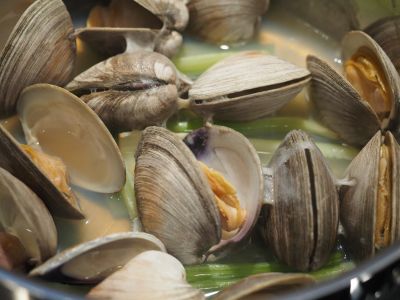
2. Storing the Clams >>
3. Prepping the Clams >>
4. Choosing the right pot >>
7. Cooking the clams >>
9. Preparing the clam broth >>
1. Selecting the right clams for your recipe
When you go to your fishmonger in search of clams you will encounter different names for the hard shell clams which are distinguished by size. From small to large they are countnecks, littlenecks, topnecks, cherrystones and quahogs (pronounced ko-hogs) or chowder clams. Don't get too hung up on a particular name.
All of the clams except quahogs are typically served raw on the half shell as well as in cooked recipes so they are all good. Quahogs are tougher and are most often used in soups and chowders. For identification purposes, I would consider a quahog to be any clam over 4" across the widest part of the clam. So you first need to understand your recipe and consider what you are going to do with the clams.
For example, when steaming clams to be chopped up in New England clam chowder, you usually want to select the largest hard shell clams you can find, such as quahogs or cherrystones, because they are cheaper and you are going to chop them up anyhow. If you have a recipe that features whole clams such as Linguine with Clam Sauce, little necks or countnecks would be better. For stuffed clams, like Clams Casino, you probably would use cherrystones.
And no, you can't cut a cherrystone in half and use it in place of two countnecks. The clams have a belly surrounded by muscle and if you cut it in half it will lose it's integrity and become unidentifiable as a whole clam. And in no case should you use soft shell clams which are the ones with the real long necks that hang out and are traditionally used for "steamers" in New England.
Select clams that look healthy and do not have broken or cracked shells. The clams should be tightly closed or should close when you tap on them. If they smell like anything other than the ocean don't buy them. And if you are not heading straight to a location with a refrigerator best to ask for some ice in a separate bag to pack with them for the ride.
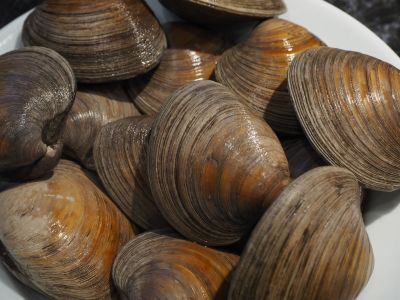
2. Storing the Clams
Once you get the clams home take them out of the bag they came in, place them in an uncovered bowl or a colander over a bowl and cover them lightly with a damp towel. Place them in the refrigerator until you are ready to use them. Do not put them in a sealed bag, they can suffocate. And do not put them in water until you are ready to clean them. An hour or two before you are ready to cook them take them out of the refrigerator and rinse them thoroughly in the sink. If they feel gritty at all you can brush them with a stiff plastic brush under running water.
3. Prepping the Clams
An hour or two before you are ready to cook them take them out of the refrigerator and rinse them thoroughly in the sink. If they feel gritty at all you can brush them with a stiff plastic brush under running water.
To make sure you get all the grit out of the clams before using them in something like Linguine with Clam Sauce, you should soak them in a 3% salt solution for about 30 minutes. If after 30 minutes there is sand in the bottom of the bowl, repeat the process until the liquid remains mostly clear. To make a 3% salt solution if you don't have a scale, you can use about 2 quarts of cold water with 5 Tablespoons of kosher salt (4 T of table salt) and you will be close enough. Make sure to mix the salt into the water really well until it is clear.
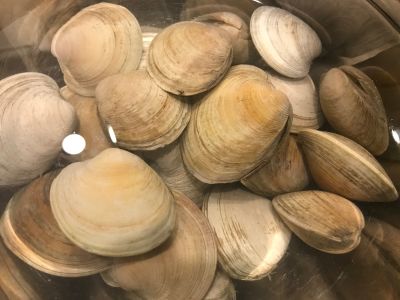
If you are using them for something like clam chowder where you will be removing them from the shell and separating them from the broth, you can go ahead and steam them without cleaning them first and then rinse them of the grit after they are removed from the shells and the broth. Also at this point you would have to strain the broth through a piece if cheesecloth to make sure no grit remains in there also.
4. Choosing the right pot
The pot is not overly critical here but there are a few things to take into account. You don't want to stack the clams too high in the pot. Ideally several layers of clams is plenty. You want to give them room to open and you want the heat to distribute evenly. The size of the pan depends entirely on how many clams you are cooking. Select a stock pan or dutch oven that is big enough to hold all the clams you have, or if you have too many do them in several batches. One that is wide as opposed to tall and narrow is preferable. The weight of the pan is not really critical.
Looking at the two pots in the picture below, the pot on the left would be preferable to the pot on the right. It is wider and has shorter sides than than the tall stock pot so would provide more even steaming of the clams.
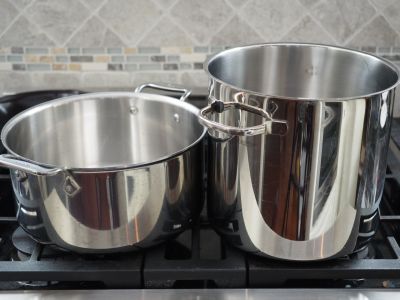
5. Choosing the right steaming liquid
You want to add enough liquid to cover the bottom of the pan by about 1/4 inch. You can use several types of liquid depending on the result you want. The liquid will be used as clam broth along with the clam liquor that will be released from the clams when they open. The most basic liquid is water. It will produce the mildest clam broth if that is what you want. You can also consider using bottled clam broth, white wine, champagne, beer or about anything else you want to experiment with as long as it will create steam when boiled. I would start with water, white wine or clam broth and then branch our from there. So decide which liquid you want and add it to the pot and next we will talk about adding even more flavor.
6. Adding aromatics and other flavors
Aromatics in cooking are basically anything that adds flavor to a broth or a dish. In French cooking the mirepoix comprises onion, celery and carrots. In Cajun cooking the holy trinity is made up of onion, celery and green bell pepper. So for vegetables it is basically anything that will add flavor and stand up to the cooking process. You can also add herbs like thyme, bay leaf, parsley, oregano or several others.
Be creative but remember it all depends on what you are going to do with the broth. The aromatics will add slightly to the flavor of the clams but will go a long way toward defining the flavor of the broth. If you are making clam chowder you might want a milder broth but if you are steaming littlenecks along with a loaf of crusty french bread to dip in the broth, you would probably want a completely different flavor profile. Aromatics are certainly one way to do that.
When I am steaming clams I like to put at least 3-4 stalks of celery on the bottom of the pan to add a mild complementary flavor and give the clams a little space off the bottom of the pan to steam. From that point I decide what else I might want to add.
7. Cooking the clams
Once you have the liquid and the aromatics in your pan, go ahead and add the cleaned clams. Bring the liquid to a boil over high heat. Cover the pot and reduce the heat to medium low so that it continues to simmer and produce steam. Cook until the clams open, about 5 to 10 minutes, but certainly no more than 15 minutes. Take the clams out of the pot as they open. Overcooking clams will make them tough and rubbery so the sooner you can get them out the better. Just put them in a bowl to catch any liquid that might run out of them.
Some may not open fully which is okay because in an earlier step we inspected the clams to make sure they were alive and healthy before we ever started. However, one word of caution, if the clams have sand in them before or after you cook them or in any way look or smell unlike the others, discard those clams. When James Bittman talks about grilled clams not opening in his book How to Cook Everything, he says
"Use a small knife to open any clams that may have remained closed; as long as they were alive to begin with, they are perfectly safe."
In the picture below all the clams were perfectly safe to eat, even those that appear to be open only slightly. And it took a knife to open those clams. Once opened they looked and smelled just like the other clams that opened fully.
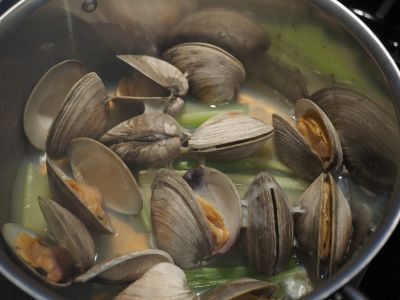
8. Preparing the cooked clams
At this point you should have a pot with broth and aromatics and a bowl with clams still in their shells along with some juices. If you are serving steamed clams, just prepare the broth as indicated below and serve the clams right out of the bowl or put them out on plates, pouring the juices into the pot with the cooking broth.
If you are using the clam meat in a dish, remove the clam meat from the shells being careful to save all the liquid that is in the clams. Discard the shells. At this point you can keep the clams in a bowl with a little of the liquid and cover them with foil. When removing the meat from the shells, try not to take the abductor muscles which are what open and close the shell as they can be very fibrous and tough.
If you are using the clams whole, you are ready to move one. If you are making a dish requiring chopped clam meat, chop the clams and pour any liquid in the clam bowl back in in with the saved broth. Put the chopped clams in a bowl and cover until ready to use.
9. Preparing the clam broth
At this point, the only thing we haven't dealt with is the broth remaining in the cooking pot. Remove any solids remaining from the aromatics. Prepare a strainer with a lining of a couple of layers of cheesecloth and pour the liquid through the cheesecloth into the container below. And you most likely will end up with more broth than you started with because of the liquor that comes out of the clams.
Next, taste your broth. This is an important step before you use it in any recipe so you know what you are adding. You may want to dilute it, add salt or pepper, or flavor it in some other way. Just a note about the clam broth you get as a result of steaming; it can be very strong so depending on your tastes, you may want to dilute it and use only a portion of it in your dish. But that's why we taste it first.
Summary
So let's go ahead and steam some clams. And feel free to adjust this based on any of the tips you learned from above.
- Add enough steaming liquid to your pot to cover the bottom by about 1/4 inch
- Add 4 stalks of celery and 1 clove of lightly crushed garlic to the pot
- Add the clams to the pot
- Bring the pot to a boil and cover
- Reduce the heat a bit but we still want it boiling enough to produce a good stream of steam
- When all the clams open they are cooked, discard any that do not open
- Remove the clams and reserve
- Strain the broth through a fine mesh strainer or cheesecloth and reserve
You now have clam broth and chopped clams ready to use in your recipe. Congratulations!Check out the BostonSidewalks recipe for New England Clam Chowder.
Share Your Opinion of this Recipe and How You "Make It Mine"
We're very glad you have chosen to share your thoughts. It's what we're all about. (All comments are moderated)
Please enter your name so people will know which comments are yours. You can use your real name or pick a user name if you prefer. To subscribe to our newsletter, enter your email address. And we never share any of your information with anyone, EVER! And if you submit a rating it must be accompanied by a comment and a name to be counted.
Get Our Newsletter!
Recent Comments
Meat Loaf
The meatloaf was moist, smooth and cooked perfectly through. The glaze was different but terrific...a nice change. Totally recommend and I give 5 s...
Eileen -- 5/17/18
I boil mine in the pressure cooker for 5 minutes, the easiest eggs to peel
Kori -- 4/10/18


